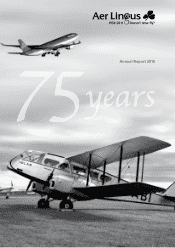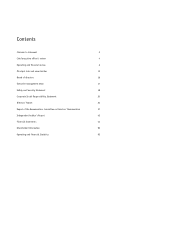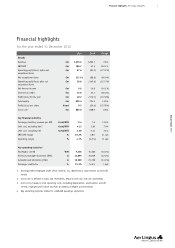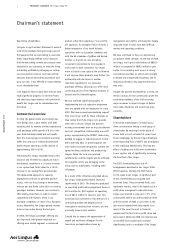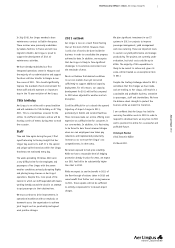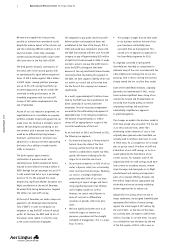Aer Lingus 2010 Annual Report Download - page 8
Download and view the complete annual report
Please find page 8 of the 2010 Aer Lingus annual report below. You can navigate through the pages in the report by either clicking on the pages listed below, or by using the keyword search tool below to find specific information within the annual report.
6
Annual Report 2010
Operating and fi nancial review Aer Lingus Group Plc
Business review
Following a €93 million operating loss in the
fi rst half of 2009 and changes in the senior
management of the Group in the autumn of
2009, substantial changes were made to Aer
Lingus’ strategy coupled with urgent actions
to address the losses. These actions included:
• Reduction of long-haul capacity and
closure of loss-making routes
• Cuts in capacity on over-served short-haul
routes
• The pricing policy was re-focused onto
yield per ASK rather than load factor
• A €97 million cost saving programme
(entitled “Greenfield”) was launched
The review of Aer Lingus’ business carried out
by the new CEO at the time led to the
conclusion that the airline had to position
itself as a “value carrier’’ because the pure low
cost/low fares model is not sustainable, whilst
a full service model would not be competitive
in the Irish market. The pure low cost/low
fares model, in the image of Ryanair, is not
sustainable for Aer Lingus for the following
reasons:
• Deeply discounted aircraft are no longer
available
• Our market proposition and customer
expectation is for central rather than
secondary peripheral airports, implying
higher airport charges
• Tax funded marketing deals with secondary
peripheral airports are no longer available
• The cost overhang of the Aer Lingus staff
seniority list
Equally, the “full service’’ model adopted by
many fl ag carriers is not competitive because:
• There is a relatively small business market
to/from Ireland
• Our Dublin hub is in a disadvantageous
geographic position for short-haul
connecting flows; and
• Most importantly, low fares are embedded
in the Irish market place and in the Irish
consumer mindset
The market positioning adopted by Aer Lingus in 2010 is summarised in the following table:
LCC
Ultra-Low Cost Savings
Aer Lingus Full Service
Flag Carriers
Target Market Price-sensitive leisure Combination of leisure and
business
Business and premium leisure
Product offering Basic seat
Very limited paid add-ons
Quality core product plus à la
carte paid options
Multiple product attributes
fully-bundled
Airport selection Secondary Central Primary
Customer engagement and
relationship management
None Natural positive engagement
Standalone FFP with selected
reciprocality
Structured approach to customer
engagement (one-to-one)
Alliance based FFP*
Customer expectations Low Medium High
Distribution channel Internet only Internet as priority but multi
channel where appropriate
Multi-channel by default
Network connectivity None Appropriate connectivity offering
at selected hubs
Emphasis on partnerships and
connectivity to other airlines
Alliance based with complex
connectivity across several hubs
Brand image Downmarket Professional but affordable Polished, upmarket
Airport & online check-in Additional charge No charge No charge
Seat selection Additional charge for priority
boarding
Majority of seats available for free
selection 24 hours in advance of
fl ight. Paid selection for some
front of cabin seats
No charge
* Note: FFP = frequent fl yer programme
Operating and fi nancial review

